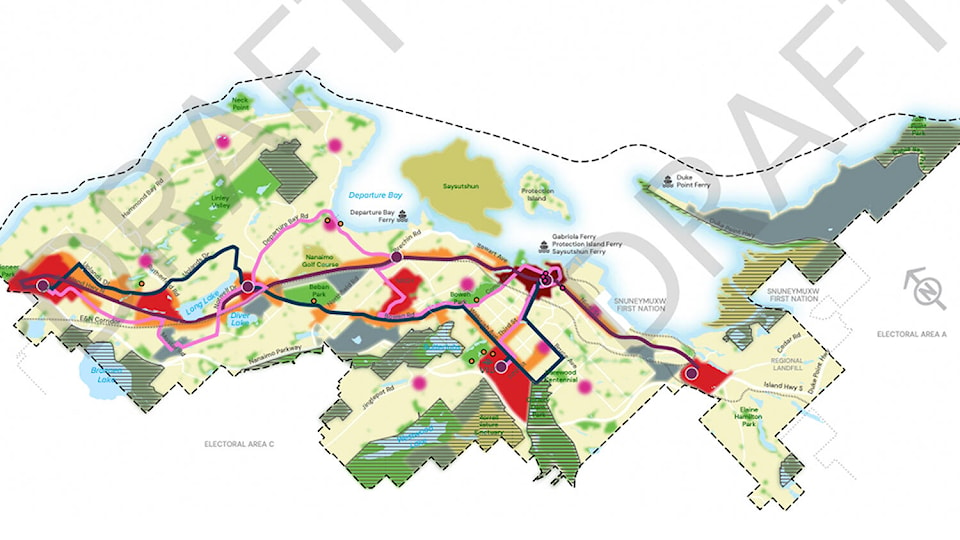Nanaimo’s next official community plan has been drafted and citizens are encouraged to take a look before it is potentially adopted this summer.
The City of Nanaimo announced this week that it is entering the final phase of engagement regarding ReImagine Nanaimo, a new master plan for the city that will replace not only the existing OCP, but a number of other policy documents.
The draft plan offers guidance on land use and future growth, but layers the OCP with planning around transportation and active mobility, climate action and resiliency, accessibility and inclusion, and parks, recreation and culture, as well as Nanaimo’s doughnut framework.
“This was a bit of an experiment…” said Lisa Bhopalsingh, director of community development, at a city council meeting Monday, Feb. 28. “We have yet to find another local government in Canada who’s attempting to do something like this.”
The ReImagine Nanaimo plan’s goals are meant to overlap and align with goals set out in the Regional District of Nanaimo’s regional growth strategy.
“Nanaimo is the primary focus point for the majority of urban growth for the region and as such, we play a really important role by absorbing most of the future growth and development in our region,” Bhopalsingh said, suggesting that containing growth in Nanaimo helps protect the watershed, resource lands and “all the other rural attributes” of the region.
The draft land-use plan offers some tweaks from the previous OCP. The 2008 Plan Nanaimo identified five urban centres across the city, but the 2022 draft OCP ups that to seven – one urban centre downtown and six secondary urban centres, adding Nanaimo North Town Centre and Country Club Centre (the others are Woodgrove, the hospital district, the university district and Chase River).
Target densities in the draft OCP are 250 or more units per hectare in the downtown and 200 units per hectare in secondary urban centres, with both of those target densities increasing from 150 or more units per hectare. Target density is 100 units per hectare on corridors along major arteries and collector roads, and a variety of densities up to 60 units per hectare in other neighbourhoods.
READ ALSO: Census shows Nanaimo is one of Canada’s fastest-growing metropolitan areas
EDITORIAL: We have a say in how our city of 100,000 grows
ReImagine Nanaimo is structured around five goals: resilient and regenerative ecosystems; equitable access and mobility; community well-being and livability; reconciliation, representation and inclusion; and a thriving and resilient economy.
Councillors praised the plan at a governance and priorities committee meeting Feb. 28, with Coun. Zeni Maartman calling it “an incredible plan” and the product of a lot of work and community engagement, and Coun. Don Bonner calling it a “fabulous document [that’s] going to lead us through the better part of the next generation.”
Coun. Ben Geselbracht said the city’s decision to integrate various city plans seems to have been a good one.
“Going through it, I definitely can appreciate and see the care taken to sort of have a coherent whole and a sound rationale and logical basis for how it’s set up,” he said.
Councillors discussed the language in the document, debating whether the aspirational statements were worded too strongly or not strongly enough.
“For each goal, it becomes a very complex conversation around how much jurisdiction we have, what’s the urgency, what’s the specificity,” said Geselbracht.
Bhopalsingh said the ReImagine Nanaimo plan will be accompanied by integrated action plan and monitoring plan, and there will be measurable targets and indicators. She said “the rubber hits the road” with the actions council takes and the budget resources it devotes to different priorities each year.
“The action plans … will be scripted out separately and won’t be adopted by bylaw, so there will be a lot more latitude going forward to go through those and build them into work plans every year,” added Jake Rudolph, chief administrative officer.
Mayor Leonard Krog said he thinks the ReImagine Nanaimo draft plan “hits the right tone” of recognizing what the municipality can do in terms of city-building and place-making while acknowledging the role of other levels of government, the private sector and the non-profit sector.
“This is a pretty impressive document and I suspect the ultimate compliment will be that a number of other communities may skip some of the process and come and look at what Nanaimo’s done here in this draft and copy it,” he said.
Nanaimo residents are now being asked for their feedback until April 8 and can complete an online survey at www.getinvolvednanaimo.ca/reimagine-nanaimo. The anticipated timeline is for city council to give first and second readings to the plan in May, with a public hearing to follow in June and potential adoption of the plan in July.
RELATED: City of Nanaimo surveying residents to inform long-term planning
editor@nanaimobulletin.com
Like us on Facebook and follow us on Twitter
